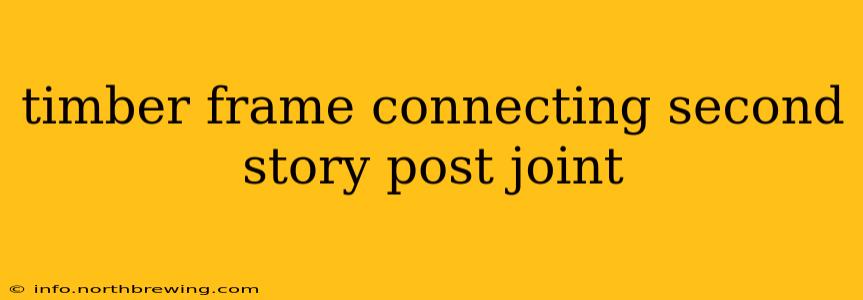Building a timber frame structure, especially one with a second story, requires meticulous attention to detail, particularly when it comes to the joinery. The connections between posts, beams, and other structural elements are critical for the building's stability and longevity. This guide delves into the various methods used for connecting second-story posts in timber frame construction, exploring their strengths, weaknesses, and suitability for different projects.
What are the Different Types of Timber Frame Joints for Second Story Posts?
Several types of joints are commonly employed to connect second-story posts in timber framing, each offering unique advantages and disadvantages. The best choice depends on factors such as the size of the timbers, the overall design of the structure, and the desired aesthetic.
Some common types include:
-
Mortise and Tenon: This classic joint involves cutting a mortise (a hole) in one piece of timber and a tenon (a protruding piece) in the other. The tenon fits snugly into the mortise, creating a strong and durable connection. Variations include through-tenons, blind tenons, and wedged tenons, each offering slightly different levels of strength and complexity.
-
Scarf Joint: A scarf joint is created by cutting angled cuts on two timbers, allowing them to overlap and interlock. This joint is often used for lengthening timbers, but can also be adapted to connect posts, though it typically requires additional strengthening elements like bolts or pegs.
-
Butt Joint: A simpler joint where the ends of two timbers meet squarely. While the simplest to create, butt joints require significant reinforcement, typically through the use of metal plates, bolts, or substantial pegs, to achieve sufficient strength for a second-story post connection.
How Strong are These Joints? Which is the Strongest?
The strength of each joint depends heavily on proper execution and the specific timber species. A well-executed mortise and tenon joint, particularly one with a wedged tenon, is generally considered one of the strongest and most reliable methods for connecting second-story posts. Scarf joints can be very strong when reinforced appropriately, but require careful planning and execution. Butt joints, while simpler, inherently lack the inherent strength of the other options and rely entirely on the reinforcement for structural integrity. The use of through-bolts and properly sized timber is crucial for all joints.
What are the Different Methods for Reinforcing Timber Frame Joints?
Regardless of the chosen joint type, reinforcement is often necessary, particularly for larger structures or those in high-wind areas. Common methods include:
-
Wooden Pegs: Traditional and aesthetically pleasing, wooden pegs provide excellent strength when properly sized and driven.
-
Metal Bolts: Bolts offer significant strength and are commonly used in conjunction with other joint types for additional security. The size and number of bolts will depend on the size of the timbers and the anticipated loads.
-
Steel Plates: Steel plates provide substantial reinforcement, particularly for butt joints or other joints requiring increased strength. They can be customized to fit various joint types and timber dimensions.
What Kind of Wood is Best for a Second Story Post?
The best type of wood for second-story posts depends on factors like availability, budget, and local building codes. However, hardwoods such as oak, Douglas fir, and Southern yellow pine are frequently used for their strength and durability. The wood must be properly seasoned to minimize shrinkage and warping.
What are the Common Mistakes to Avoid When Connecting Second Story Posts?
Several common mistakes can compromise the strength and longevity of second-story post connections. These include:
- Inadequate Joint Design: Choosing a joint type unsuitable for the load-bearing requirements.
- Poorly Executed Joints: Sloppy craftsmanship leading to loose fits or misalignments.
- Insufficient Reinforcement: Failing to adequately reinforce the joint with pegs, bolts, or plates.
- Using Unseasoned Timber: Unseasoned timber is prone to shrinkage and warping, weakening the joint over time.
How Do I Choose the Right Joint for My Project?
The selection of the appropriate joint depends on several interacting factors. You should consult with a qualified timber frame builder or structural engineer to determine the best approach for your specific project. Factors to consider include:
- Building codes and regulations: Local regulations might dictate specific joint requirements.
- Structural load calculations: These calculations determine the necessary joint strength.
- Aesthetic preferences: Certain joints offer a more traditional or modern look.
- Skill level: Some joints are more complex to construct than others.
Careful planning and execution are essential for creating strong and durable connections in timber frame structures. By understanding the various joint types, reinforcement methods, and potential pitfalls, you can ensure the safety and longevity of your building. Always consult with professionals to ensure your project meets all necessary safety and structural standards.
